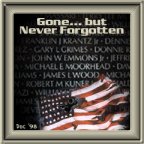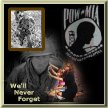SYNOPSIS:
Frustrated by problems in negotiating a peace settlement, and pressured by a Congress and public wanting an immediate end to American involvement in Vietnam, President Nixon ordered the most concentrated air offensive of the war - known as Linebacker II - in December 1972. During the offensive, sometimes called the "Christmas bombings," 40,000 tons of bombs were dropped, primarily over the area between Hanoi and Haiphong. White House Press Secretary Ronald Ziegler said that the bombing would end only when all U.S. POWs were released and an internationally recognized cease-fire was in force.
On the first day of Linebacker II, December 18, 129 B52s arrived over Hanoi in three waves, four to five hours apart. They attacked the airfields at Hoa Lac, Kep and Phuc Yen, the Kinh No complex and the Yen Vien railyards. The aircraft flew in tight cells of three aircraft to maximize the mutual support benefits of their ECM equipment and flew straight and level to stabilize the bombing computers and ensure that all bombs fell on the military targets and not in civilian areas.
The pilots of the early missions reported that "wall-to-wall SAMS" surrounded Hanoi as they neared its outskirts. The first night of bombing, December 18 and 19, two B52s were shot down by SAMs.
Onboard the first aircraft shot down on December 18 was its pilot, LTCOL Donald L. Rissi and crewmen MAJ Richard E. Johnson, CAPT Richard T. Simpson, CAPT Robert G. Certain, 1LT Robert J. Thomas and SGT Walter L. Ferguson. Of this crew, Certain, Simpson and Johnson were captured and shown the bodies of the other crew members. Six years later, the bodies of Rissi, Thomas and Ferguson were returned to U.S. control by the Vietnamese. Certain, Simpson and Johnson were held prisoner in Hanoi until March 29, 1973, when they were released in
Operation Homecoming.
Capt. Hal K. Wilson was in the lead aircraft of a B52 cell from Utapao. Also on board his aircraft were crew men MAJ Fernando Alexander, CAPT Charles A. Brown, Jr., CAPT Henry C. Barrows, CAPT Richard W. Cooper Jr. (the navigator), and SGT Charlie S. Poole (the tailgunner). Wilson's aircraft was hit by a SAM near his target area and crashed in the early morning hours of December 19, sustaining damage to the fuselage. In the ensuing fire, there was no time for orderly bailout, but as later examination of radio tapes indicated, all six crewmen deployed their parachutes and evidently safely ejected. The aircraft damage report indicated that all six men were prisoner.
Radio Hanoi announced in news broadcasts between 19 and 22 December that the six crewmen had been captured. When the war ended, however, only four of the crew returned from Hanoi prisons. Hanoi has remained silent about the fate of Charlie
Poole and Richard Cooper.
The Christmas Bombings, despite press accounts to the contrary, were of the most precise the world had seen. Pilots involved in the immense series of strikes generally agree that the strikes against anti-aircraft and strategic targets was so successful that the U.S., had it desired, "could have taken the entire
country of Vietnam by inserting an average Boy Scout troop in Hanoi and marching them southward."
To achieve this precision bombing, the Pentagon deemed it necessary to stick to a regular flight path. For many missions, the predictable B52 strikes were anticipated and prepared for by the North Vietnamese. Later, however, flight paths were altered and attrition all but eliminated any hostile threat from the ground.
Linebacker II involved 155 Boeing B52 Stratofortress bombers stationed at Anderson AFB, Guam (72nd Strat Wing) and another 50 B52s stationed at Utapao Airbase, Thailand (307th Strat Wing), an enormous number of bombers with over one thousand men flying the missions. However, the bombings were not conducted
without high loss of aircraft and personnel. During the month of December 1972, 61 crewmembers onboard ten B52 aircraft were shot down and were captured or declared missing. (The B52 carried a crew of six men; however, one B52 lost carried an extra crewman.) Of these 61, 33 men were released in 1973. The others remained missing at the end of the war. Over half of these survived to eject safely. What happened to them?
Reports mount that have convinced many authorities that Americans are still held captive in Southeast Asia. Are Poole and Cooper among them? Do they know the country they love has abandoned them? Isn't it time we found them and brought
them home?
NOTE: The Egress report states "B52 compartment full of fire, Cooper failed to eject. fireball, desinigration."





